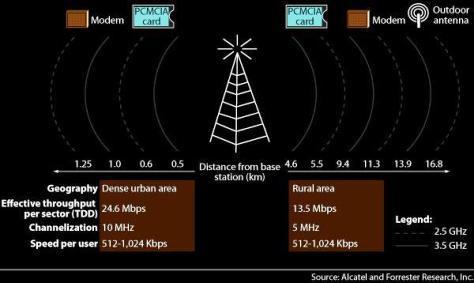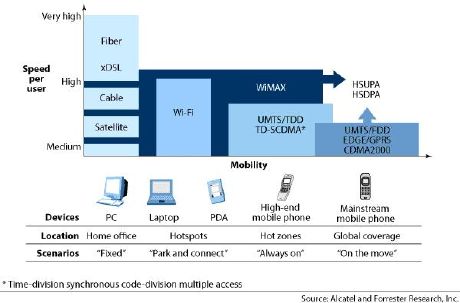Guest Post by Babar Bhatti
 Pakistan’s telecommunication industry – mobile communication in particular – has made impressive strides in the last few years after deregulation. However broadband growth in the country has been very disappointing – there are less than 100,000 broadband users in Pakistan. The open competition observed in mobile industry has not been replicated to broadband. Reasons include high prices, control of PTCL over bandwidth resources, policy issues, lack of infrastructure and legal disputes.
Pakistan’s telecommunication industry – mobile communication in particular – has made impressive strides in the last few years after deregulation. However broadband growth in the country has been very disappointing – there are less than 100,000 broadband users in Pakistan. The open competition observed in mobile industry has not been replicated to broadband. Reasons include high prices, control of PTCL over bandwidth resources, policy issues, lack of infrastructure and legal disputes.
Enter WiMAX. Simply stated, it’s a relatively new standards-based wireless technology which is intended for large coverage areas on the order of several kilometers (instead of a few hundred meters, as is the case with Wi-Fi).
With base stations transmitting signals and some equipment at customer location, it promises fast bandwidth for both fixed locations and mobile users. In this backdrop, Pakistan made headlines in 2006 when Wateen announced plans to work with Motorola to rollout Mobile WiMAX, the largest network of its kind in the world.
Is WiMAX (Worldwide Interoperability for Microwave Access) the right technology for developing countries? In other words, will this new technology deliver the promise of broadband at affordable prices?

WiMAX comes with many theoretical advantages but its potential is yet unproven. Without getting too technical, it is purpose-built for Internet (IP) communication and is based on standards (as opposed to other proprietary solutions) endorsed by a respected world standards body, the Institute of Electrical & Electronic Engineers (IEEE)*.
In 2002 WiMAX was identified by Intel as an alternative or complement to the wireless broadband. Eventually Motorola and Intel became its biggest champions. On the other side of the camp were GSM operators of the world who saw WiMAX as a competing technology. As with any new technology, a lot of lobbying was done to make it an industry wide accepted technology. According to BusinessWeek,
“(Intel) rounded up a remarkable coalition of chip, PC, consumer electronics, networking, and software companies in an effort to radically reshape the future of broadband with what’s now called WiMAX.”
In addition to broadband Internet access, applications that are supportable with WiMAX supports multiplayer interactive gaming, streaming media, VoIP, video and teleconferencing, and media content downloads.
Even today the industry is full of discussions and debates, comparing WiMAX with technologies such as 3G. About 65 countries are experimenting with WiMAX and the results will vary by country depending on the spectrum availability, existing infrastructure and market conditions.
Coming back to Pakistan, the major initiatives include:
(1) Wateen – which is using WiMAX solution from Motorola and its cable/fiber network to offer triple play of phone, TV and broadband. Trials have been extended for over a year. Most aggressive to market their bundled solutions, they have started advertising without providing pricing and availability information.
(2) Mobilink – has formed a new entity called Link Dot Net (LDN) to focus on broadband market. WiMAX infrastructure was piloted by Mobilink in 3 cities and a recently issued RFP has generated 7 proposals to cover 5 major metros, including in-building coverage for high value business areas. Malaysia’s Dancom, which conducted early trials of WiMAX in Karachi, was acquired by Mobilink’s LDN in 2007. Mobilink also bought DV Com and its licenses.
(3) Burraq Telecom – which was acquired by ACT consortium which includes Qatar Telecom and Clearwire Corporation, an American operator providing WiMAX services in 10 countries, also plans to offer WiMAX.
The pricing has not been announced by these companies yet. Business users in Pakistan desperately need reliable broadband and are the desired customers because of their high affordability levels. Consumer market is different as demand varies by demographics’ low price is the dominating success factor.

Currently the high prices of WiMAX ‘customer premises equipment’ (CPE) make it more expensive than fiber, cable or DSL. Wateen and others are counting on the trend of falling hardware prices for WiMAX. They would have to compete with the latest PTCL broadband campaign in which PTCL has dramatically reduced DSL prices at Rs 1200 per month for 256kbps speed with a 2GB limit. As a last mile solution, WiMAX may not compete on price at this time but if WiMAX is reliable, fast and operators provide better customer service then business users may pay some premium for it, say as a replacement for leased lines.
There are other potential benefits of WiMAX such as broadband access for rural areas or for areas that have no other reasonable broadband access. This is likely to be play an important role for developing countries. WiMAX can also reduce cost of transmission lines such as backhauls from cellular sites or cross-town links. To summarize, improved access and mobility are the major advantages promised by the WiMAX camp.
What about the existing telecom infrastructure in Pakistan? For one, the GSM infrastructure in Pakistan is mainly focused on voice. 3G licenses are expected to be awarded at the end of 2007, paving the way for HSDPA – the high speed standard for GSM – in Pakistan . The existing 2 or 2.5G mobile Internet is available in selected areas and the number of users for the mobile broadband services remains low. It is yet to be seen if WiMAX, with its higher speeds** and costs, will find a large number of users in this category in Pakistan.
Spectrum is another important factor – even a show-stopper – in many countries where spectrum availability can mean all the difference. For Pakistan, PTA, the communications regulatory body has allocated spectrum in 3.5 GHz range for WiMAX. The CDMA wireless phone operators such as PTCL (Vfone) and Worldcall, which offer limited mobility, also have licenses in the 3.5GHz range and they are also likely to offer WiMAX services after getting approvals from PTA.
Notes:
* Fixed and mobile WiMAX are the 2 major choices, the standards for fixed (IEEE 802.16d) were defined in 2004; the mobile standard (IEEE 802.16e) has been recently finalized. WiMAX 802.16d has limited radio features; enhanced and standardized interoperable radio performance comes with WiMAX 802.16e.
** The claimed speeds for WiMAX vary making it difficult for people to get an idea of the real-life performance they are expected to get.
References: Motorola: [1] and [2] Wateen: [3] and [4] Others: [5], [6], and [7]




















































@Owais
Yes. Wimax has old roots in Pakistan. Supernet was the pioneering company back in 2000 to have installed a WiLAN network (the company, WiLAN, is based in Canada and has patents for the generic OFDMA technology and these days earns its revenue via royalty of its IPR). Supernet later installed Aperto (Rehan Jalil of CA) which was a pre-Wimax network, the pre-Wimax thing being the result of the standards not yet been ratified till then.
The environment right now with the operators are that they are contemplating hard between the fixed d and the mobile e standards. The prices are still high and no one except the huge guys (Wateen, Mobilink) are in the mood of becoming a statistic for the rest of the industry.
Everyone is waiting for someone to start and the prices of the CPE to fall from the current $250 ea in bulk to the sweet spot of ~$80-$50 ea so that the basic case of mass deployment be achieved.
Whether for good or bad, one thing is clear – Pakistan will soon become a study center for Wimax deployment for the rest of the world.
Babar, thanks for bringing this piece of great news to us.
Intel is banking on WiMAX to enter the smart-phone and mobile hand-held market. Intel is finding that the PC and notebook markets have hit saturation points or will hit saturation points in the next few years. It will be the mobile hand-held devices which will dominate the consumer market and provide the greatest growth opportunities for Silicon manufacturers in the coming years. Intel does not have a presence in this market as it is totally dominated by ARM (Advanced Risc Machines), a British IP (Intellectual property) company. Intel by pushing WiMAX as an alternate to 3G broadband is hoping that it will be able to provide an alternate to ARM architecture. WiMAX modems (communication solutions) will appear as embedded within Intel architecture based chipsets for PCs and notebooks first. This will also enable the infrastructure developers like Motorola to rollout their WiMAX networks . However Intel is actually targeting the mobile handheld market where it is developing IA (Intel architecture) based solutions as an alternate to ARM technology. With the WiMAX infrastructure in place, Intel is hoping that it will be able to sell a lot of chips (read 100s of millions) in the mobile handheld space targeted towards products like smartphones, ultramobile PCs etc., breaking ARMs total dominance in this market. It also thinks that this is the only way to stave off ARM from encroaching the PC market.
What does this mean for consumers in Pakistan? As this article points out, this is all good news, as the rollout of WiMAX will perhaps bring the much needed relief from PTCL’s total monopoly on bandwidth, and hence the dismal broadband penetration in Pakistan. It is the mass usage of broadband which will open up plethora of opportunities both for enterprising businesses to provide consumer based solutions, as well as making the lives of consumers better. For developing markets like Pakistan, price is the key, and once the providers understand that, they will be able to penetrate the market just like they did with cell phones. It will be interesting to see how long that takes.
Some sort of WiMAX has been operational in Pakistan since 2004 (or may be before). I know a WiMAX similar network called SuperNet had their transponder afixed above Habib Bank Plaza in Karachi. What I am not sure is if SuperNet followed IEEE 802.16d protocol or not. A Standardised protocol (802.16d and e) based WiMAX is definitely a great news for Pakistan and a leap forward in telecom infrastructure development. Couple of years ago I saw 802.16d compliant CPEs manufactured by Taiwanese OEMs and at that time their price ran in couple of thousands of dollars. I am sure the price must’ve come down significantly by now.
Wateen is offering free CPEs to first 10,000 customers who’ll register for the service at it’s website.
WIMAX is pretty exciting — it gives Pakistan the capability to possibly “leapfrog” to the next generation of world-class network ahead of the rest of the world. While there are some problems, such as cost that is mentioned, those will steeply decline as the technologies are adopted. Many manufacturers are now embedding WIMAX chips in everything from computers to phones to cars.
Excellent article.